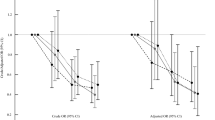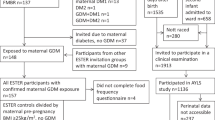Abstract
Background/Objectives:
An association between biomarkers of trans fat intake and greater risk of preeclampsia has been reported, but research in this area is scant. Thus, we examined the association of second trimester intake of trans fats with risk of preeclampsia and severe preeclampsia.
Subjects/Methods:
We followed 67 186 pregnancies of women participating in the Danish National Birth Cohort between 1998 and 2003. Diet was assessed with a food frequency questionnaire at gestation week 25, and preeclampsia diagnosis was obtained by linkage with the Danish National Patient Registry.
Results:
There were 1804 cases of preeclampsia and 402 cases of severe preeclampsia identified in the cohort. Intake of trans fats decreased during the study period as a consequence of a reduction in industrial trans fat intake. Second trimester intake of trans fats was unrelated to risk of preeclampsia or severe preeclampsia. The relative risk (95% confidence interval; P, trend) of preeclampsia and severe preeclampsia comparing top to bottom quintiles of trans fat intake were 0.95(0.81; 1.11, 0.33) and 1.07 (0.78; 1.48, 0.92), respectively.
Conclusion:
Second trimester intake of trans fats is unrelated to risk of preeclampsia within the intake range observed in a period of gradual reduction of industrial trans fats from the Danish food supply.
This is a preview of subscription content, access via your institution
Access options
Subscribe to this journal
Receive 12 print issues and online access
$259.00 per year
only $21.58 per issue
Buy this article
- Purchase on Springer Link
- Instant access to full article PDF
Prices may be subject to local taxes which are calculated during checkout
Similar content being viewed by others
References
Andersen LT, Jensen H, Haraldsdottir J (1996). Typiske vægte for madvarer. Scand J Nutr 40, S129–S152.
Baer DJ, Judd JT, Clevidence BA, Tracy RP (2004). Dietary fatty acids affect plasma markers of inflammation in healthy men fed controlled diets: a randomized crossover study. Am J Clin Nutr 79, 969–973.
Bysted A, Mikkelsen AÆ, Leth T (2009). Substitution of trans fatty acids in foods on the Danish market. Eur J Lipid Sci Technol 111, 574–583.
Danish Food Administration (2000). The composition of foods.
Duley L (2009). The global impact of pre-eclampsia and eclampsia. Semin Perinatol 33, 130–137.
Fitzmaurice GM, Laird NM, Ware JH (2004). Marginal Models: Generalized Estimating Equations (GEE). In: Fitzmaurice GM, Laird NM, Ware JH (eds). Applied Longitudinal Analysis. Wiley & Sons: Hoboken, NJ, pp 291–321.
Goldman-Wohl D, Yagel S (2009). Preeclampsia—a placenta developmental biology perspective. J Reprod Immunol 82, 96–99.
Jakobsen MU, Bysted A, Andersen NL, Heitmann BL, Hartkopp HB, Leth T et al. (2005). Intake of ruminant trans fatty acids in the Danish population aged 1–80 years. Eur J Clin Nutr 60, 312–318.
Khan KS, Wojdyla D, Say L, Gülmezoglu AM, Van Look PFA (2006). WHO analysis of causes of maternal death: a systematic review. Lancet 367, 1066–1074.
Klemmensen AK, Olsen SF, Osterdal ML, Tabor A (2007). Validity of preeclampsia-related diagnoses recorded in a national hospital registry and in a postpartum interview of the women. Am J Epidemiol 166, 117–124.
Kuklina EV, Ayala C, Callaghan WM (2009). Hypertensive disorders and severe obstetric morbidity in the United States. Obstet Gynecol 113, 1299–1306.
L’Abbe MR, Stender S, Skeaff CM, Ghafoorunissa, Tavella M (2009). Approaches to removing trans fats from the food supply in industrialized and developing countries. Eur J Clin Nutr 63, S50–S67.
Lain KY, Roberts JM (2002). Contemporary concepts of the pathogenesis and management of preeclampsia. JAMA 287, 3183–3186.
Lefevre M, Lovejoy JC, Smith SR, DeLany JP, Champagne C, Most MM et al. (2005). Comparison of the acute response to meals enriched with cis- or trans-fatty acids on glucose and lipids in overweight individuals with differing FABP2 genotypes. Metabolism 54, 1652–1658.
Leth T, Bysted A, Hansen K, Ovesen L (2003). Trans FA content in Danish margarines and shortenings. J Am Oil Chem Soc 80, 475–478.
Lopez-Garcia E, Schulze MB, Meigs JB, Manson JE, Rifai N, Stampfer MJ et al. (2005). Consumption of trans fatty acids is related to plasma biomarkers of inflammation and endothelial dysfunction. J Nutr 135, 562–566.
Mahomed K, Williams MA, King IB, Mudzamiri S (2007). Erythrocyte omega-3, omega-6 and trans fatty acids in relation to risk of preeclampsia among women delivering at Harare Maternity Hospital, Zimbabwe. Physiol Res 56, 37–50.
Mikkelsen TB, Olsen SF, Rasmussen SE, Osler M (2007). Relative validity of fruit and vegetable intake estimated by the food frequency questionnaire used in the Danish National Birth Cohort. Scand J Public Health 35, 172–179.
Mikkelsen TB, Osler M, Olsen SF (2006). Validity of protein, retinol, folic acid and n?3 fatty acid intakes estimated from the food-frequency questionnaire used in the Danish National Birth Cohort. Public Health Nutr 9, 771–778.
Mozaffarian D, Aro A, Willett WC (2009). Health effects of trans-fatty acids: experimental and observational evidence. Eur J Clin Nutr 63, S5–S21.
Mozaffarian D, Pischon T, Hankinson SE, Rifai N, Joshipura K, Willett WC et al. (2004). Dietary intake of trans fatty acids and systemic inflammation in women. Am J Clin Nutr 79, 606–612.
Oken E, Ning Y, Rifas-Shiman SL, Rich-Edwards JW, Olsen SF, Gillman MW (2007). Diet during pregnancy and risk of preeclampsia or gestational hypertension. Ann Epidemiol 17, 663–668.
Olsen J, Melbye M, Olsen SF, Sørensen TI, Aaby P, Andersen AM et al. (2001). The Danish National Birth Cohort—its background, structure and aim. Scand J Public Health 29, 300–307.
Olsen SF, Mikkelsen TB, Knudsen VK, Orozova-Bekkevold I, Halldórsson TI, Strøm M et al. (2007). Data collected on maternal dietary exposures in the Danish National Birth Cohort. Paediatr Perinat Epidemiol 21, 76–86.
Rifas-Shiman SL, Rich-Edwards JW, Willett WC, Kleinman KP, Oken E, Gillman MW (2006). Changes in dietary intake from the first to the second trimester of pregnancy. Paediatr Perinat Epidemiol 20, 35–42.
Riserus U, Arner P, Brismar K, Vessby B (2002). Treatment with dietary trans10 cis12 conjugated linoleic acid causes isomer-specific insulin resistance in obese men with metabolic syndrome. Diabetes Care 25, 1516–1521.
Roberts JM, Balk JL, Bodnar LM, Belizan JM, Bergel E, Martinez A (2003). Nutrient involvement in preeclampsia. J Nutr 133, 1684S–1692S.
Sun Q, Ma J, Campos H, Hankinson SE, Hu FB (2007). Comparison between plasma and erythrocyte fatty acid content as biomarkers of fatty acid intake in US women. Am J Clin Nutr 86, 74–81.
van Poppel G (1998). Intake of trans fatty acids in western Europe: the TRANSFAIR study. Lancet 351, 1099.
Willett WC, Stampfer MJ (1986). Total energy intake: implications for epidemiologic analyses. Am J Epidemiol 124, 17–27.
Williams MA, King IB, Sorensen TK, Zingheim RW, Troyer BL, Zebelman AM et al. (1998). Risk of preeclampsia in relation to elaidic acid (trans fatty acid) in maternal erythrocytes. Gynecol Obstet Invest 46, 84–87.
Acknowledgements
The work reported in this manuscript was supported by the March of Dimes Birth Defects Foundation (6-FY-96-0240, 6-FY97-0553, 6-FY97-0521, 6-FY00-407), EU (QLK1-CT-2000-00083), Danish National Research Foundation, Danish Medical Research Council (9601842 and 22-03-0536), Danish Health Foundation (11/263-96), Danish Heart Foundation (96-2-4-83-22450) and the National Institute for Diabetes and Digestive and Kidney Diseases (5P30DK46200-18).
Author information
Authors and Affiliations
Corresponding author
Ethics declarations
Competing interests
The authors declare no conflict of interest.
Rights and permissions
About this article
Cite this article
Chavarro, J., Halldorsson, T., Leth, T. et al. A prospective study of trans fat intake and risk of preeclampsia in Denmark. Eur J Clin Nutr 65, 944–951 (2011). https://doi.org/10.1038/ejcn.2011.66
Received:
Revised:
Accepted:
Published:
Issue Date:
DOI: https://doi.org/10.1038/ejcn.2011.66
Keywords
This article is cited by
-
Fat intake during pregnancy and risk of preeclampsia: a prospective cohort study in Denmark
European Journal of Clinical Nutrition (2019)
-
The association between dietary factors and gestational hypertension and pre-eclampsia: a systematic review and meta-analysis of observational studies
BMC Medicine (2014)



